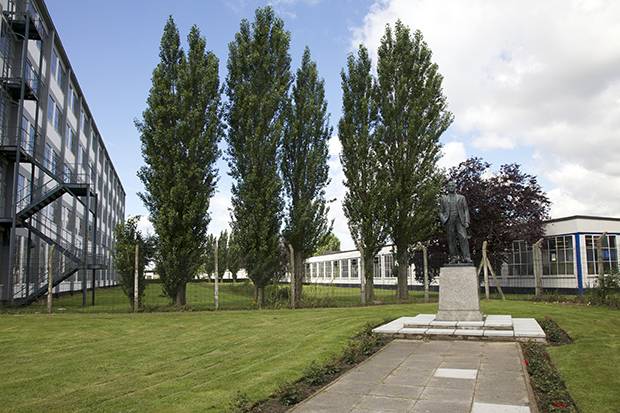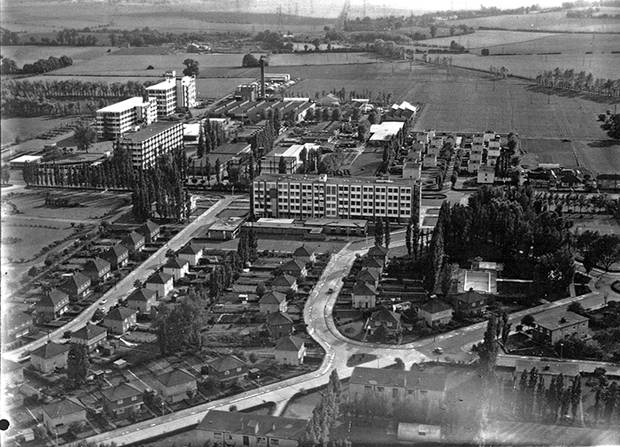In the Thames-side village of East Tilbury, 50 kilometres east of London, Mike Tabard is paging through old issues of the Bata Record in a wide, windowed former factory. The self-published broadsheets sit amid other artifacts from the days that town life revolved around the legendary footwear brand: Second World War uniforms worn by employee servicemen, Czech-English dictionaries and riding-boot lasts.
In the mid 20th century, "Bata was a world empire and East Tilbury was the 'head office,' with 3,000 workers at its height," says Tabard, chair of the Bata Heritage Centre. After the last factory closed, the low-slung building behind the Bata ballroom – now a supermarket that still boasts its original terrazzo floor – housed the relics of its operations. But after a fire destroyed the centre last January, the soot-stained collection has lived here, awaiting a $40,000 restoration.
Many Canadians might not realize that Batawa, the southeastern Ontario factory town founded by the company in 1939, is just one of many similar cities around the world. And just as the brand behind them has begun to revive its footwear for a young audience discovering its retro aesthetic, the villages it built are attracting residents smitten with the modernist style prescribed by their founder, Tomas Bata.
Bata was onto something timeless when he planned this model development to replace his Czech headquarters, doomed to nationalization between the World Wars. Today, East Tilbury's young middle-class families are moving into its cul-de-sacs, conceptualized by students of Le Corbusier and Frank Lloyd Wright. Next year, a local developer will break ground on a housing community mimicking the flat-roofed "Bata look." And in November, Radical Essex, an organization devoted to the history of the area, will publish a guide to modernism in the county of Essex, branding East Tilbury as a hothouse of mid-century architecture and radical social ideals.

Today, East Tilbury is enjoying renewed interest among architectural historians and fans of modernist design.
Built to Bata's specs in the 1930s with its own schools, fire station, library and cinema, East Tilbury is benefiting from a growing interest among heritage architecture bodies to recognize the value of interwar architecture. Radical Essex recently curated a program of tours through the community. The local borough developed a GPS-based app that launches into historical commentary when you approach local landmarks such as the memorial to Bata-employed soldiers, an employees-only tennis courts or the gleaming-white five-storey factories.
The renewed interest in Bata company towns isn't limited to East Tilbury. In Lorraine, France, residents are repopulating the ghost town of Bataville, built in 1931 and deserted since the factories closed in 2001. Bata Park in Möhlin, Switzerland, 200 kilometres from the company's current world headquarters in Lausanne, is undergoing its own renovation to restore its mid-1930s fabric.
"They are all an integral part of the story," says Charles Pignal, a great-grandson of Tomas Bata. "The history of 'Batavilles' like Tilbury is something I mention heavily when presenting our activities to customers. They are a key part of the presentation of our brand."
The resurgence of the Bata name, 120 years after the first Bata shoes were created and a generation since they fell out of fashion, may seem random, but consumers often need time to become nostalgic about a brand in order to appreciate its revival. Similar to the rebirth of heritage sportswear companies like KWay and Tretorn, Pignal took advantage of that longing when, three years ago, he helped launch Bata Heritage, a reboot of classic Bata styles like the Hotshot beloved by the late grunge musician Kurt Cobain. "When I meet people in any market, I often hear, 'Oh Bata. I used to wear those when I was a kid. Those were my cool shoes.' My grandfather used to hear the same thing," says Pignal. "I thought, 'Why should people feel they could only wear Bata as a kid?'"
Since its inception, Bata Heritage has joined forces with Toronto's Drake General Store on a limited line of Bullets, the rubber-toed sneakers sold by the millions in the 1970s and 1980s. It also collaborated with Comme des Garçons founder Rei Kawakubo on a range of polka-dot canvas Bata Tennis shoes for Dover Street Market and co-designed a line of monochrome Bullets with the Paris shop Colette. Whether its factory towns or its footwear, Bata seems poised to rise again.
Visit tgam.ca/newsletters to sign up for the Globe Style e-newsletter, your weekly digital guide to the players and trends influencing fashion, design and entertaining, plus shopping tips and inspiration for living well. And follow Globe Style on Instagram @globestyle.
